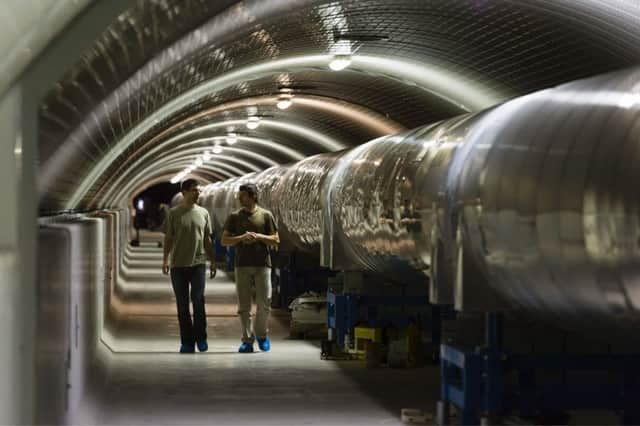Scots scientists help to make gravitational waves discovery


A team from Glasgow University made key upgrades to giant detectors which enabled them to capture the 1.3 billion-year-old “thud” from one of the waves – which finally proves the universe can be “heard”.
Gravitational waves are like ripples on a pond created by far-off cataclysmic events such as the collision of black holes. They spread across space, minutely distorting everything in their path.
Advertisement
Hide AdAdvertisement
Hide AdThe discovery could shed new light on mysteries such as dark matter and dark energy, and even the so-called Big Bang and the birth of the universe.
The waves, detected on 14 September last year, came from two black holes combining in an enormous collision that happened at a time when life was just forming on Earth. Scientists believe it opens up huge new potential for further discoveries about the universe, and compared it to the achievements of 17th century astronomer Galileo.
The detection of gravitational waves comes exactly a century after Albert Einstein predicted their existence in his General Theory of Relativity. He received an honorary degree from Glasgow University in 1933, when he gave a lecture there.
France Cordova, director of the US National Science Foundation, said: “Einstein would be beaming. This is a very, very special moment. We are seeing the universe with new eyes in an entirely new way.”
The discovery was made possible by Glasgow University’s work to improve the twin detectors in the United States, which are the most sensitive instruments every built.
The Laser Interferometer Gravitational-Wave Observatory (Ligo) detectors can measure the distance between the sun and its nearest star to the width of a human hair.
The 2½-mile long detectors are at opposite ends of the US, at Livingston in Louisiana in the south-east and 2,000 miles away at Hanford in Washington State in the north-west.
The upgraded detectors also hit success almost as soon as they were turned on.
Advertisement
Hide AdAdvertisement
Hide Ad• READ MORE: Gravitational waves discovery: The facts explained
Prof Ken Strain, of Glasgow University’s Institute for Gravitational Research, said: “We tuned up the detector over several weeks, and during the last steps, the signal came in.
“It was literally as it was being switched on, in the first few hours. The universe was kind to us. Some of the technology we contributed has been absolutely fundamental to this progress.”
Ligo was first proposed as a means of detecting gravitational waves 30 years ago by a group of scientists including Professor Ron Drever, formerly of Glasgow University.
Kip Thorne, from the California Institute of Technology, and one of Ligo’s co-founders, predicted they had opened a new window that would produce “even bigger surprises” than discoveries made by previous X-ray, optical and radio telescopes. This will be assisted by more detectors being developed in other countries.
Glasgow University plans to remain at the forefront of Ligo’s development with further work to increase the sensitivity of the detectors ten-fold over the next three years.
Prof James Hough, the longest-serving member of the Glasgow team, who has worked on gravitational waves for 45 years, said it was more important than the discovery of the Higgs boson, the so-called “God particle” linked to atomic mass, in 2012.
He said gravitational waves were “the biggest scientific breakthrough of the century”.
Advertisement
Hide AdAdvertisement
Hide AdProf Martin Hendry, the university’s head of physics and astronomy, said he could not overstate the magnitude of the event which produced the detection. It was the equivalent of three times the mass of the Sun being converted into waves in an instant.
Glasgow University principal Anton Muscatelli told members of its team gathered to watch the announcement from Washington DC that it was a “Eureka” moment. He said: “We will be part of a historic moment to look back on, and say ‘I was there’.
“For more than 40 years, Glasgow University scientists have been on the quest for Einstein’s elusive ripples in spacetime, and have played a key role.”
The team cheered as physicist Prof David Reitze, from the University of Florida, said: “We have detected gravitational waves. We did it. This is the first time the universe has spoken to us through gravitational waves. We were previously deaf to gravitational waves. We can now hear them.”
Gabriela Gonzalez, from Louisiana State University, said the waves detected were short and sounded like a thump. Slowing the recording produced a “rumbling noise, then a chirp”.
She said: “We can hear gravitational waves – we can hear the universe.”
Glasgow University’s 60-strong group is the largest of a contingent of 140 in the UK and among the 1,000 people working on the project. Others include scientists from Strathclyde University and the University of the West of Scotland.